How Much Exercise Does a Miniature Dachshund Need?
I see it time and time again: People saying they think Dachshunds don’t need much exercise or that they are not capable of doing much because their backs are fragile.
It frustrates me though because I see so many Dachshunds that are overweight and I’m sure it’s the misconceptions about Dachshunds and exercise that significantly contributes to that.
Just because Dachshunds are nicknamed “sausage dogs”, doesn’t mean they should look like one (it’s speculated that they got the nickname because the German hot dog was named after the breed).
UPDATED: February 2, 2023
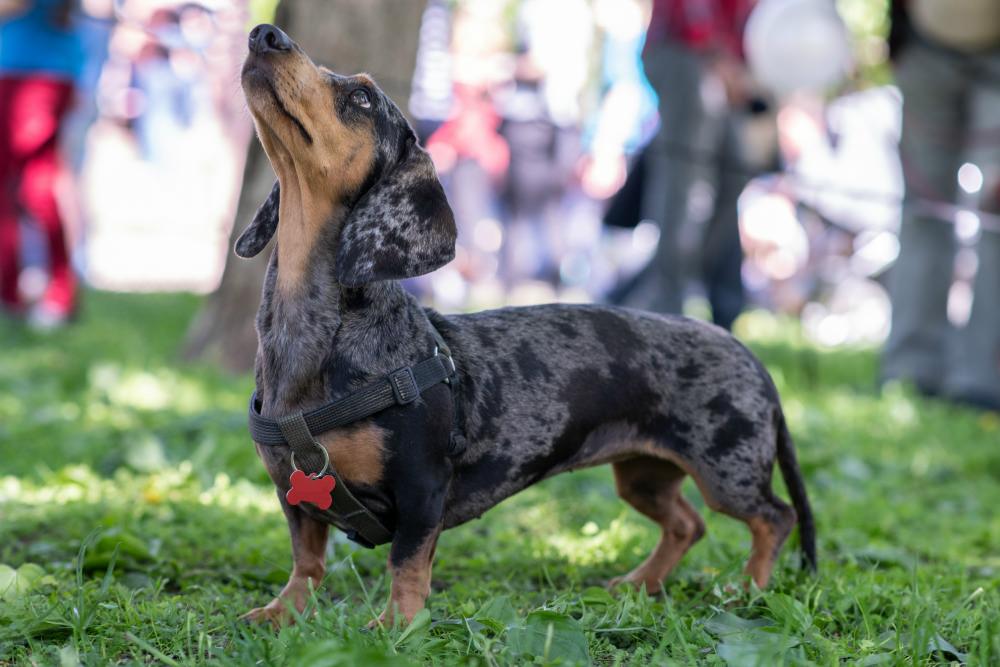
It’s important that a Dachshund be exercised regularly to help prevent obesity, health issues, and to help them live longer.
It’s also very important to keep a Dachshund fit and active to help prevent IVDD and related back injuries.
Luckily, Dachshunds have the natural ability to exercise because they were bred to be tenacious and athletic hunters!
These early little warriors were charged to track game through the woods and dig into underground tunnels after badgers, rabbits, and foxes.
So, how much exercise does a miniature Dachshund need to keep them healthy and happy?
Note: Although they may require more exercise due to their larger size, the exercise requirements for standard Dachshunds is very similar.
How Much Exercise Do Dachshunds Need?
How much exercise a Dachshund needs can vary, based on factors such as age or health issues.
However, a healthy, adult Dachshund generally needs a minimum 45-60 minutes of purposeful exercise a day.
It’s been found that merely letting your Dachshund run around the yard is not sufficient exercise for a Dachshund.
Instead, a Dachshund should get a minimum of 1 hour of moderate exercise as many days of the week as possible.
Factors That May Limit Your Dachshund’s Ability to Exercise
The above general recommendation assumes that a Dachshund is a healthy adult.
There are several cases where a Dachshund’s ability to exercise may be diminished.
Dachshund Puppies – 0-12 months
The muscular skeletal system of young dogs is still developing during the first year so you should wait until your puppy is old enough for strenuous physical activity.
While normal levels of activity including play with other puppies or running around in the yard are not a cause for concern, it can be unwise to start activities such as leashed jogging, prolonged swimming, excessive and repetitive jumping, hiking, or very long walks.
The general rule for puppy exercise is 5 minutes of walking per month of age up to twice a day.
So, for example, a 4 month old puppy could walk up to 20 minutes twice a day.
Although this is a general guideline, and the 5-minute rule has come in to question more recently, it’s good too err on the side of caution with your puppy.
I know what raising a Dachshund puppy is like though – they can be crazy, which can make you question your sanity.
If your puppy is interested in walking a little more than the 5 minute rule suggests, it may be ok as long as it’s self paced and you don’t force them to go on.
Note: As an alternative to more exercise, you can also tire your puppy out with brain games and training.
Dachshund puppies are done with most of their growth by 12 months of age so you will only need to limit their activity until then.
Senior Dachshunds – 7+ years
A Dachshund is considered a senior dog somewhere between the age of 7 and 10 years old (it depends on other health factors too, not just a specific age).
Senior dogs eventually start to slow down and may not be able to exercise as long, or as rigorously, and they could when they were younger.
They still need exercise though to help keep their joints lubricated and muscles from getting stiff.
The “move it or lose it” mantra applies to a dog’s physical fitness too – it’s not just for humans.
You just may need to walk at a slower pace and break their exercise into smaller chunks.
For example, instead of walking your senior Dachshund 40 minutes a day, take your dog for two 20-minute walks instead.
Remember that it’s important to watch your senior Dachshund’s weight because less exercise means they need fewer calories.
If your senior Dachshund isn’t exercising as much but eating the same amount of calories, they could gain weight, which will put extra pressure on their bones, joints, and spine.
Dachshunds with an Illnesses
There are several illnesses that can limit your Dachshund’s ability to exercise.
These include arthritis, heart disease, and obesity (yes, it’s considered an illness).
If your Dachshund has an illness, discuss their exercise needs with your vet and how to exercise your Dachshund safely.
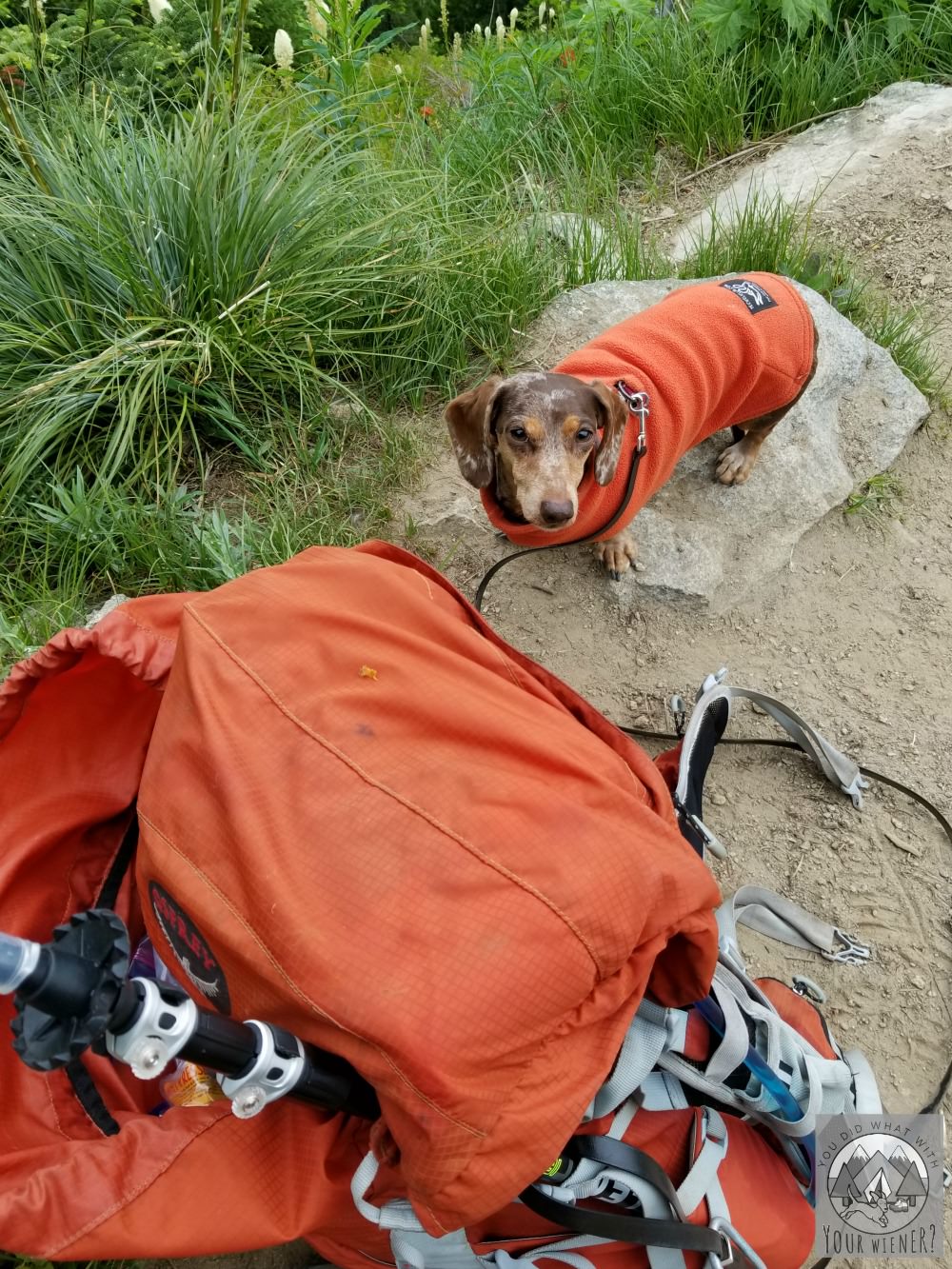
IVDD and the Myth of the Delicate Doxie
Intervertebral Disc Disease (IVDD) is a potentially paralyzing genetic condition that is somewhat common among breeds with short legs (a.k.a. chondrodystrophic) such as Basset Hounds, Beagles, Pekingese and Dachshunds.
Almost every Dachshund owner aware of a Dachshund’s propensity for back injury (up to 25%) fears IVDD.
However, this fear is a big misguided as the disease is primarily genetic, largely out of the owner’s control, and almost every single Dachshund has some degree of it.
But scientist do acknowledge that there are lifestyle factors that influence whether a Dachshund will suffer and IVDD-related back injury.
One of these is exercise… but not in the way that you might think.
Highly or moderately active Dachshunds may experience less back injuries
The 2015 DachsLife Survey, aimed at identifying lifestyle factors that may influence IVDD and related back injuries, found:
- Highly or moderately active Dachshunds over the age of 3 had half the rate of IVDD incidents as dogs that were described as mildly active or inactive.
- Dachshunds that exercised for more than 1 hour per day were at decreased odds of IVDD.
- Dachshunds exercises with only free running and playing in the yard were 1.8 times more likely to suffer an IVDD-related back injury.
The recommendation for exercise restriction applies to the recovery period after a back injury
Extreme exercise restriction is a typical post-operative prescription after a Dachshund has spinal surgery to treat this debilitating condition.
It is also the most significant factor in a “conservative treatment” (treatment without surgery) protocol.
However, there is no reason to assume that restricted exercise is necessary for a Dachshund that has not been diagnosed with IVDD.
Also, even though every case is different, it’s not a given that any dog who has suffered an IVDD related injury can no longer live an active life.
In fact, there is evidence suggesting that exercise can ward off disc calcification, an early symptom of what can develop into IVDD.
The UK Dachshund Breed Council, one of the premier authorities on IVDD, clearly recommends plenty of age/fitness appropriate exercise for Dachshunds.
Jumping and stairs
Are you hand wringing over your Dachshund jumping on furniture and using stairs?
There is a potentially positive correlation between stairs and of IVDD injuries.
The 2015 DachsLife study mentioned above found that healthy 3-year-old Dachshunds allowed to use stairs daily had lower incidents of IVDD (Read more about Dachshunds and stair here).
Being aware of the IVDD warning signs, and knowing what to do if your Dachshund shows any of them, remains a critical part of responsible wiener dog ownership.
However, using IVDD as an excuse to allow your little athlete to become an obese lap potato just isn’t doing right by your dog.
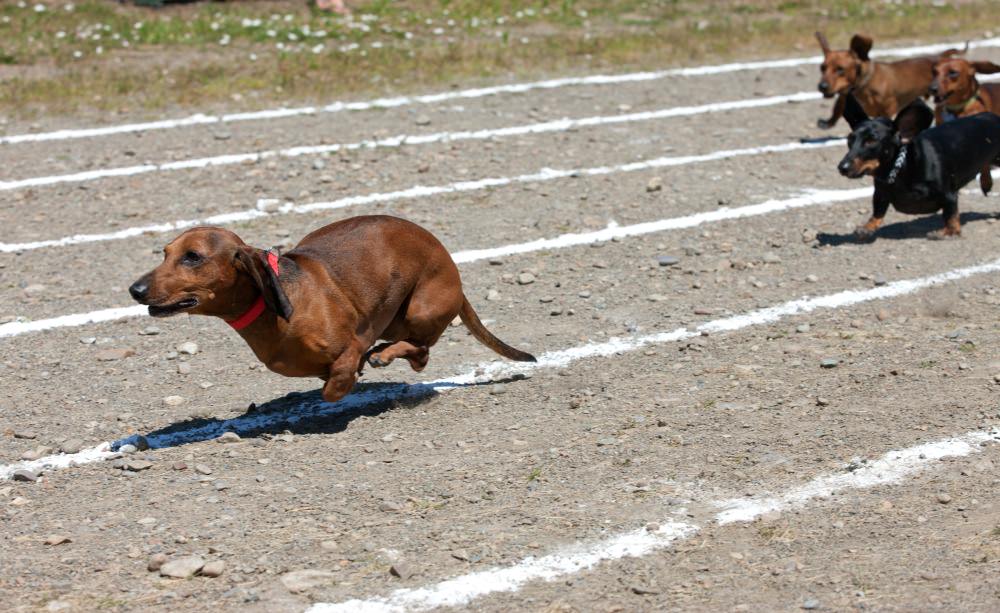
7 Ways to Exercise Your Dachshund
Most people think of walking when they envision exercising their dog.
While walking is probably the best and easiest type of exercise for Dachshunds, it’s by no means the only option.
They continue to prove their athletic prowess by participating in many dog sports.
1) Walking
Walking doesn’t take any special skill or equipment and can be done right from your front door.
Because of the convenience, this is probably how most Dachshunds get their exercise.
But be sure that you are walking your Dachshund long enough and frequently enough to gain the physical benefits though.
2) Earthdog Trials
Their natural athleticism and scent acumen makes Dachshunds particularly skilled at Earthdog trials.
Caged vermin are placed in a network of tunnels and Earthdogs learn to chase and “work” the quarry (although they cannot harm the rats).
As their skills improve, Earthdogs progress through a hierarchy of titles: Introduction to Quarry, Junior Earthdog, Senior Earthdog, and Master Earthdog.
3) Field Trials
In Dachshund field trials, Doxies are set in pairs, called “braces,” that are put on the scent of live rabbits and are then released to show off their scent tracking and quarry chasing skills.
They don’t catch or harm the rabbits, rather, they are judged for their ability to hold the trail of their quarry.
Successful participants can win points towards the AKC Field Champion Title.
4) Agility
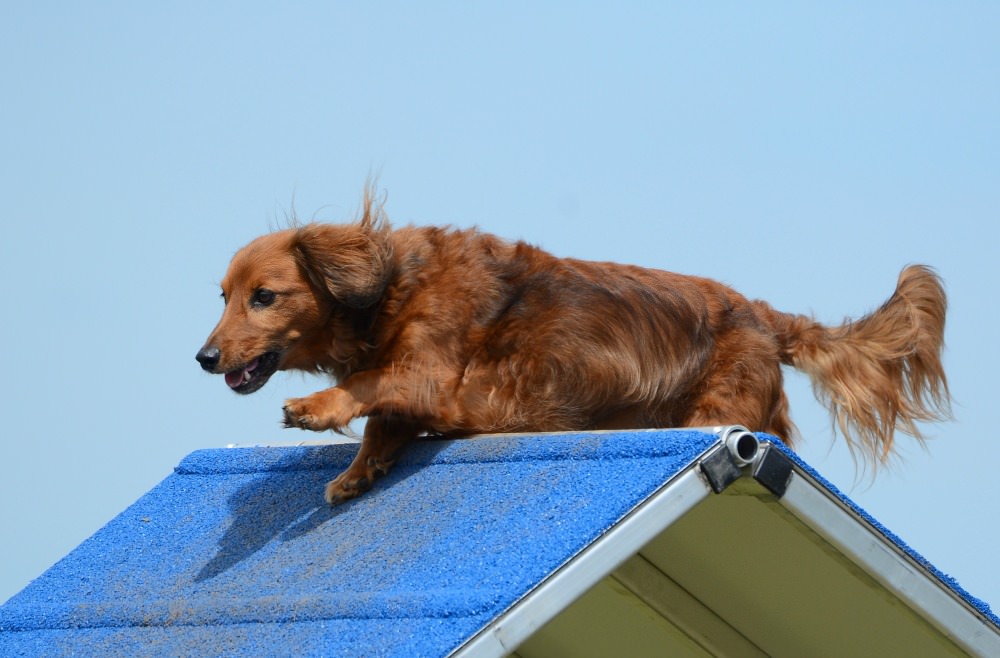
Although there are other breeds better suited for the wide range of skills it takes to win competitive agility, that doesn’t stop wiener dogs and their owners from loving the sport.
Their determination, love of adventure, and excellent trainability makes Doxies delightful partners on the agility field, although a well-honed sense of humor is required.
5) Swimming
Contrary to popular belief, not all Dachshunds dislike water.
There are many Dachshunds that love to swim in the lake or pool.
Swimming is a good way for your Dachshund to get exercise, and help to build their muscles, without a lot of impact on their joints.
6) Hiking
Sniffing through the woods is literally in the Dachshund blood and most take to it right away.
Many Dachshunds, including mine, can hike long distances to high elevations.
You might be surprised how far these small dogs can hike.
My Dachshund are not the only ones who are capable of, and love, hiking though.
7) Running
While it’s not for every Dachshund, it’s is not inherently unsafe for a Dachshund to run.
Some are quite capable.
I know several Dachshunds that have run a marathon – 26.2 miles – and more than once!
One of my Dachshunds used to run 8 miles with me.
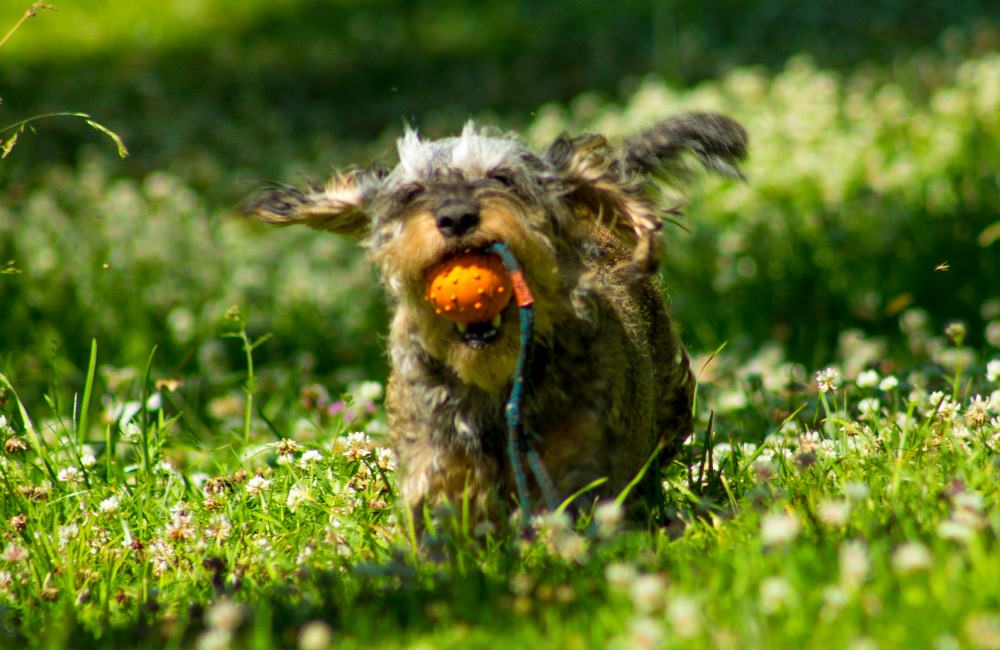
Final Thoughts
It should be clear by now that Dachshunds are not meant to be sedentary lapdogs.
In fact, they need more exercise than what most people think.
Healthy, adult Dachshunds should get at least 1 hour of exercise a day 4-7 times a week.
Remember that walking is not the only way to exercise your Dachshund.
Fun games like fetch and find it (nosework) will engage your wiener dog both physically and mentally.
Note: it’s best to avoid games like tug-of-war, or activities that cause a lot of twisting, which can put undue stress on the neck and spine.
Dachshund Friendly Dog Sports are also a good way to exercise your Dachshund (and some will exercise you too!)
Flyball, Earthdog, Scent Work, and Agility are all good examples.
If the weather is poor, you can entertain and exercise your dog indoors too.
Remember to introduce exercise gradually and check with your vet if you have any questions.
If your Dachshund is in poor physical condition, rushing into strenuous exercise too fast can result in injury.
Give your dog some time to build up muscles to support his neck, spine and joints.
Hopefully this article gave you a different perspective on miniature Dachshunds and inspired you to make sure you yours is getting enough exercise.
Because Wiener dog are certainly not lapdogs!
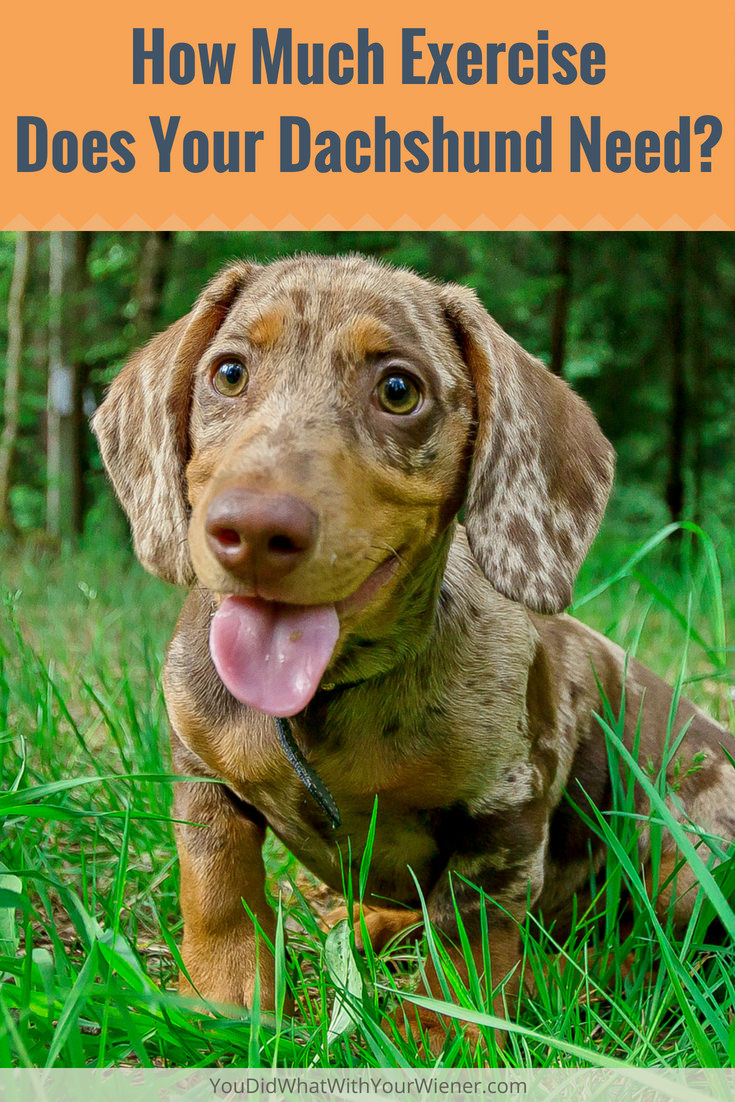

About the Author
Hi, I’m Jessica. I’ve been studying the Dachshund breed since 2007, owned 3 of my own, and shared in the lives of thousands of others through their owner’s stories. When I’m not sharing what I know on this blog, you can find me hiking, camping, and traveling with my adventurous wiener dogs.

MOST IMPORTANT: Well Balanced HEALTHY food. I hav had “Doxies” 30+ yrs. The VERY WORST THING you can do is JUNK FOOD & SWEETS…These dogs hav a VERY SENSITIVE PANCREAS…NO FATS.
My six months old mini dachshund walks about 30 minutes a day and loves it! She gets cross when we pick her up.When can she walk freely? We are concerned about her growth plates so don’t want to get it wrong.
Hi Janice. The conservative recommendation for a puppy is no more than 5 minutes of activity for every month of age. And that is up to twice a day. Since your baby is 6 months old, 30 minutes is appropriate. Just be sure to keep an eye on her to make sure he doesn’t get too tired. You’ll know when she starts to slow down, starts to walk with a limp, or lays down and refuses to walk.
What kind of dog food do you recommend?
I have a fenced backyard with three dachshunds, and 3 other dogs, I find that they run around on their own during warmer days
That definitely works for some dogs. My Dachshund needs at least a couple of miles of walking or hiking (minimum) to give her sufficient exercise (tire her out).
We have a 9 month old Long haired Standard red Dax, she is Very clever and beautiful, mad as a hatter.
She does seem very big even for a standard Dax, do they grow that big? We have called her Jessika with a K, !
Nice article Jessica. Thanks !
Hi Marianne. What does your Dachshund weigh? A standard Dachshund, according to the American Kennel Club standard, can weight 16-32 lbs. Unfortunately, and I’m definitely not saying this is you, many people let their Dachshunds get significantly overweight so they think they have a standard when they really have a tweenie (not an official classification, just a nickname for the in-between size or mini (11 lbs max). Your pup is young but nearing physical maturity size-wise so my best guess is that she may gain another 25% of her body weight between now and when she is full grown. My Dachshund Gretel was as long as she was going to get at about 9 months but she did fill out (width) a little. My current puppy is about 9.5 lbs at 6 months (she’s definitely a big puppy). I expect she may be somewhere between 12 and 17 lbs full grown. I hope that helps give you an idea. If you know how much she weighed when she was born, you can find “small dog” puppy growth charts online that can help you determine how big she will be when she is full grown (but they are just an approximation).
My Sugar loves to go mushroom hunting. It’s our favorite time of year.
What kind of mushrooms do you hunt? I sometimes think Summit would be a good truffle hunter 🙂
how much is too much exercise for a puppy? Aria is 7 months and yesterday we did a 4 miles walk with no issues – we usually walk for over 1 hour at the park at least 3 times a week. Was it too much? She didn’t show breathing issues or tiredness :/
Hi Valentina. Generally, without knowing your dog, I would say that a 4-mile walk, if it is on flat ground, may be ok for a 7-month dog (if you have a Dachshund or other small dog). The main issue is that you don’t want them to do a lot of exercise until their bone growth plates have closed. Although it’s specifically about hiking, the advice in this article also applies to walks: https://youdidwhatwithyourweiner.com/how-old-should-my-puppy-be-before-they-hike/
We have 2 minis, Hercules (11 weeks, 5 lbs), and Millie (12 years, 13 lbs). How much excersize should they get? This past week, we’ve been taking them on a walk that’s about two blocks down from our house, two blocks back, daily. Is that enough?
Hi Harley. I didn’t say specifically how much exercise a Dachshund needs in the article because each dog is different. The two important things to know are that they DO need to be active and to learn when they’ve had enough by showing signs they are tired (or too much!). The second part is what only you can determine. This article may help you decide when he’s tired. It’s aimed at hiking but really applies to any activity. https://youdidwhatwithyourweiner.com/how-to-know-when-your-hiking-dog-may-be-injured-or-sick/
With that being said, in my opinion, 4 blocks a day barely classifies as a walk. It’s more of a little jaunt. My advice for exercising a Dachshund, if walking, and if there are no known or underlying medical issues preventing it, is to start with 30 minutes of steady walking 4-5 days a week (not stopping to sniff every 5 minutes). 30 minutes a day may be more than enough for your older Dachshund. 30 minutes a day might be enough to help your younger one stay out of trouble at home (no excessive chewing on things he shouldn’t, exhibiting other behavior issues, generally getting into trouble all of the time, etc.) or it may be barely enough. I suggest starting with the 30 minutes but increasing either the number of days, times per day he is walked, or time/distance for Hercules if you think he needs or can handle more.
My dachshund hates exercise. Seems to suffer from agrophobia. I have been owned by 5 other daxies in the past, this is the first who acts like a sulky teenager, not getting out of bed before 9:00 and snoozing and avoiding anything active until lunchtime. He is a rescue dog – has anyone any ideas how to deal with him. He hates change and doesn’t cope with campervan holidays or different areas for walks. He freaks out with fear and refuses to move. He is now 6 years old, he came to live with me when he was 3. I have stopped the aggression and non-socialising but this fear of the different or change is something I have been unable to overcome.
Hi Sandra. Thanks for rescuing him. It certainly sounds like he is fearful and anxious. That would explain his fear of new places, the “scary” outside, etc. It’s very common in rescues and Dachshunds (or dogs) in general that weren’t properly socialized when they were young. You could talk to your vet about a small amount of medication you could give him every day to help him live a more stress-free life. Some dogs take very low doses of Prozac. If you want to go the natural route, VetriScience Composure or Hemp CBD has works wonders when Gretel gets really anxious.
Our doxie, Manny, is almost 2 yrs old. He and I have been walking together since day 1. Short, safe walks his first year. Now, just under 2.5 miles a day. Still safe, but more obstacles. During our hot summer months, early morning and late afternoon. He loves the cooler months and is getting where 2 miles per walk is what he needs. I can’t wait to take him hiking!
Hi. Three weeks ago, We rescued two 8-year-old doxies that are bonded sisters. They were checked out by the rescue organization’s vet and classified as obese, weighing in just over 20 pounds. They essentially lived 24/7 in a house and were free fed. We have them on a low carb diet and are getting them used to walks as they had no leash experience either. They are getting better on a leash and are increasingly being socialized. They were disinclined to walk on rough surfaces like gravel at first but they are handling new things better. How long should I walk them and how frequently?
Hi Dakota. Thanks for giving them such a great home. My article gives my general recommendation on walking but, of course, there are always special circumstances. I would err on the side of making the walks shorter and then build up depending on their interest and how well they are handling it. The minimum I would start with is 15 minutes and then work up from there is 5 minute increments. I see no reason they couldn’t pretty quickly work up to walking 45 minutes or so. As a contrast, just to give an idea, my 18 month old Dachshund who is healthy has to walk at least 45 minutes a day to sleep well through the night. She can hike with me up to 11 miles in a day (6 or 7 hours of activity).
What is the most amount of exercise a puppy can take? Yesterday, Aria and I walked 4 miles and had no issues – we typically walk at least one hour at the park 3 times a week. It was too much, was it not? There was no sign of fatigue or breathing problems.
Hi. I have an article that will answer your question. You can read it here: https://youdidwhatwithyourweiner.com/how-old-should-my-puppy-be-before-they-hike/